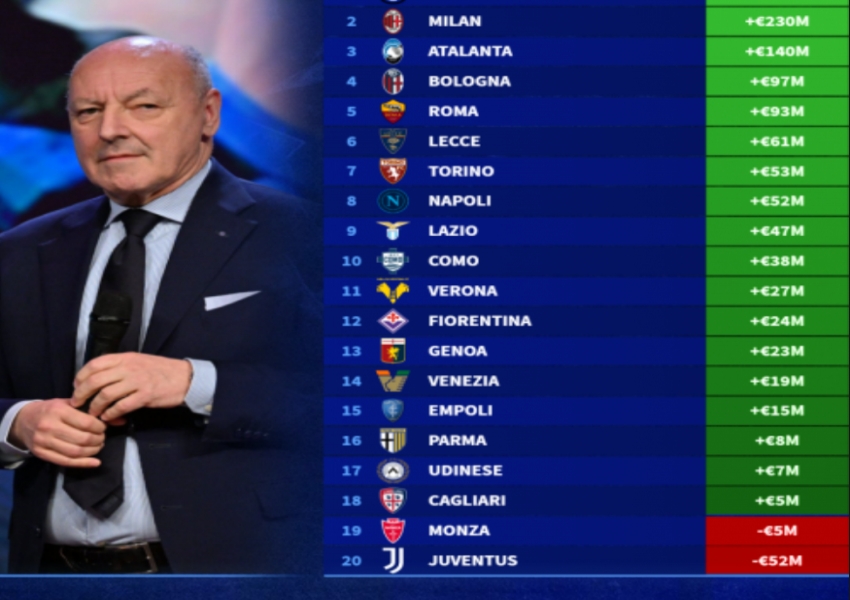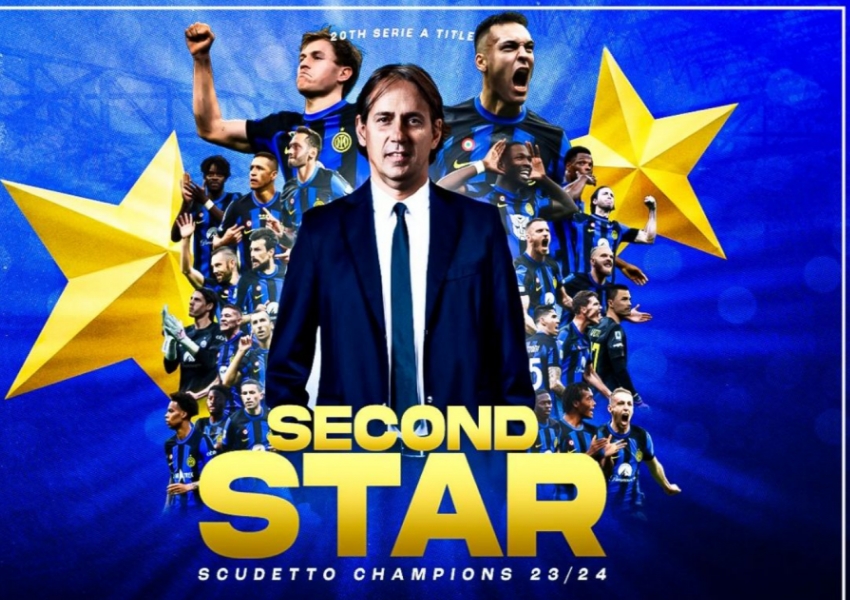Inter's Wage Surge Driven by Unmatched Squad Valuation Growth: A Five-Year Budget Comparison of the Milan Rivals
Inter Milan’s financial situation has been the subject of much discussion recently, particularly after the club’s salaries for the 2023-24 season were made public. Concerns about rising wages and financial sustainability have left some fans anxious, fearing that the club could face a financial crisis. However, while it’s important to recognize the challenges that come with increased spending, it’s also essential to understand the positive factors driving this change. Inter’s overall wage bill for the current season has risen to €141.7 million (including taxes but excluding performance-related bonuses), an increase of €20.3 million compared to last year — a 16.8% rise that puts them at the top of Serie A in terms of payroll.

In comparison, Juventus’ wage bill stands at €111.7 million, and AC Milan’s at €104.3 million, while smaller clubs like Atalanta (€59.2 million) and Bologna (€36.1 million) together still don’t match Inter’s total. Naturally, such high wages have raised concerns about financial fair play (FFP) compliance, and while these concerns are not unfounded, there are several reasons behind this wage increase — and not all of them are negative.

One of the primary reasons for Inter’s rising wage bill is the club’s recent on-field success. Over the past four years, Inter has won two Serie A titles, reached the UEFA Champions League final, and lifted multiple domestic trophies. In football, when a club performs well, it generates additional revenue, which is often used to reward players with improved contracts. This is a standard practice in the game. Clubs like Inter must follow the game’s unwritten rules by offering competitive wages to retain their top players. Refusing to do so, as Aurelio De Laurentiis at Napoli has shown, can lead to internal friction and a loss of morale.

The Thohir era, when Inter’s wages were kept under tight control, was a reflection of the team’s struggles at the time. Inter was consistently a mid-table side under Thohir, barely qualifying for the Europa League. In such a situation, players had little leverage to demand higher salaries. But keeping wages low at the cost of competitive performance is a trade-off that has limited value. Inter, as one of Italy’s most storied clubs, should always strive for success. Given the choice between winning trophies and increasing wages or saving money while finishing mid-table, the club should always choose the former. This is what defines the essence of a club like Inter.
Another significant factor driving Inter’s wage growth is the rise in market value of their players. According to data from Transfermarkt, Inter’s current squad was assembled for a total of €321.3 million, but the current market value of the team is €673.3 million — a €352 million increase. This represents the largest increase in squad value among all Serie A clubs, ahead of AC Milan’s €259.8 million rise, Atalanta’s €205.4 million, and Juventus, who have seen no growth in this area. When players' market values skyrocket, their wages typically follow suit. This is especially true for players like Alessandro Bastoni, Nicolò Barella, Lautaro Martínez, and Federico Dimarco, whose performances have seen their transfer values soar.
When a club sees this kind of growth in player value, there are two typical responses. The first option is to sell the players while their value is high and turn that estimated value increase into actual profit. The second option is to give the players new contracts with higher wages, using the increased value to justify the higher salary outlay. Inter has chosen the latter approach. While there is some debate about this strategy, with some fans suggesting it would have been wiser to sell a player like Lautaro Martínez rather than extending his contract at a post-tax salary of €9.5 million, the club’s decision to maintain stability — especially during a period of shareholder transition — is understandable. Keeping key players ensures that the team remains competitive, which is crucial during times of uncertainty.
Perhaps the most important reason for Inter’s wage increase is their recent reliance on free transfers. While signing players on a free transfer saves money on transfer fees, it typically results in higher wages for the player. This is because, in the absence of a transfer fee, the player’s agent and the player himself often negotiate for a higher salary. This strategy doesn’t necessarily mean that Inter’s overall squad-building costs are higher than those of other top clubs. Under UEFA’s financial fair play regulations, a club’s total squad budget is strictly controlled, meaning that higher wages often come with lower transfer expenditures and vice versa.
Over the past five seasons, Inter has had a net transfer investment of minus €120 million, while AC Milan’s has been plus €228 million — a difference of €340 million, or approximately €68 million per season. While Inter has spent an additional €20-40 million per year on salaries and taxes compared to AC Milan, their net transfer spending has been significantly lower. To argue that Inter’s squad-building costs are higher than Milan’s, or that Milan’s business model is more efficient, would be ignoring the facts. Both clubs have spent heavily, but their spending patterns have differed. Ultimately, football clubs spend money to achieve results, and when both clubs have high costs, comparing their on-field success provides a more objective perspective.
It’s undeniable that Inter is undergoing a period of significant change, with new majority shareholders coming into the club. Over the next two to three years, more major transitions are likely to occur, including possible changes in ownership and the potential departure of key figures like CEO Beppe Marotta when their contracts expire. These changes could pose risks to the club’s sustainability in the long run, and no one can predict with certainty what will happen in the future. However, for Inter, the best way to navigate these uncertain times is to focus on the present, continue competing for trophies, and keep growing the club’s brand, fanbase, and revenue. This will give them the financial strength to weather any future storms.
While the rising wage bill is something to be mindful of, there is no need for excessive anxiety. Inter’s success on the pitch has driven much of the increase in salaries, and as long as the club continues to win, their revenues and marketability will also rise. For now, Inter remains one of Italy’s strongest teams, and the wage bill reflects that reality. In a competitive football landscape, spending is a necessity — and when that spending leads to success, it’s a price worth paying.
Copyright Statement:
Author: mrfootballer
Source: Mrfootballer
The copyright of this article belongs to the author. Reproduction is not allowed without permission.
Recommended Blog
- Will Italy's Hero Become Inter's Problem? Analyzing the Frattesi Paradox
- AFC World Cup Qualifiers: China Confident Against Saudi Arabia, Indonesia No Longer a Minnow
- Inter's Grueling Post-Champions League Serie A Schedule: Six Tough Matches Highlight the Challenge Ahead
- UEFA Nations League Matchday 2: France Cannot Afford Another Slip, Haaland Must Be Braver
- J.League Cup Quarterfinals: Kofu Favors Their Chances, Hiroshima’s Defense Looks Unbreakable
- J. League Cup: Is Yokohama F. Marinos' Revival Truly Comprehensive? Sanfrecce Hiroshima Aiming for Success on Multiple Fronts
- Brazilian Team Controversy: Why Is the Most Expensive Left-Back Overlooked? Pavard's Dilemma and Inter Milan's Lucky Charm
- Milan Derby to Decide AC Milan Manager's Fate
- Why Inter Milan Leads in Penalty Awards and Has the Fewest Cards Since Last Season
- AFC Champions League Playoff Preview: Shanghai Port Rely on Wu Lei, While Al Nassr Are More Than Just Cristiano Ronaldo
Hot Blog
- Man City’s 21-Year-Old Star Returns Home as a Hero! Receives $350,000 Mercedes, Gifts It to His Father
- AFC Champions League Quarterfinal Draw: Yokohama Faces CR7! Two High-Stakes Clashes as Japan’s Duo Battle in the Bottom Half
- Barça Unleashed: 26-Minute, 4-Goal Comeback Stuns Atlético as Flick’s Masterclass Makes History
- 175 Days on the Sidelines! Barça’s 32-Year-Old Guardian Dreams of a Champions League Comeback
- Simeone’s 8 Days of Nightmare: Champions League Exit and Two La Liga Collapses
- Messi Turns Magician with Both Feet: A 3-Second Masterclass That Left Three Defenders Helpless
- English Media: Manchester United Will Win Premier League Title in 2028! History Will Repeat Itself, Two Teams Serve as Inspirations
- 0-2 Double Defeat! China National Team Stuck at 6 Points: No More Direct World Cup Hopes, Two Crucial Matches Ahead
- China National Football Team Drops 13.6 Points, Slips to 94th in FIFA Rankings: Syria Overtakes, New 9-Year Low
- 0-0 Draw! Japan 12 Shots, 2 Missed One-on-Ones: 8 Matches, 20 Points, Group Winner, Saudi Arabia Stuck at 10 Points in 3rd